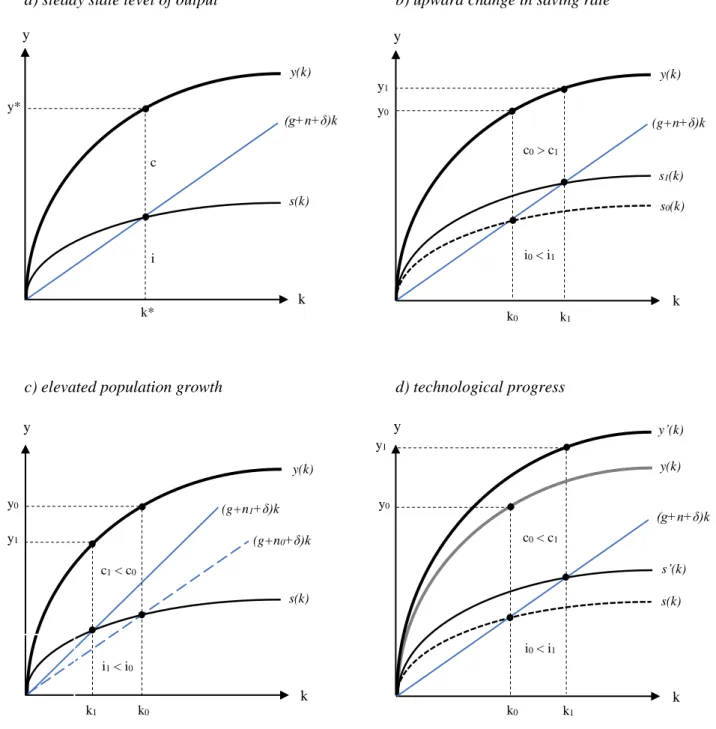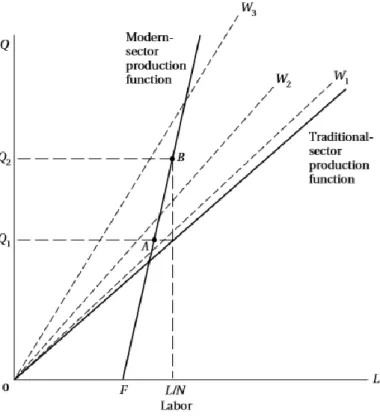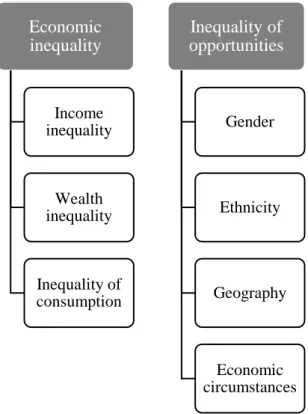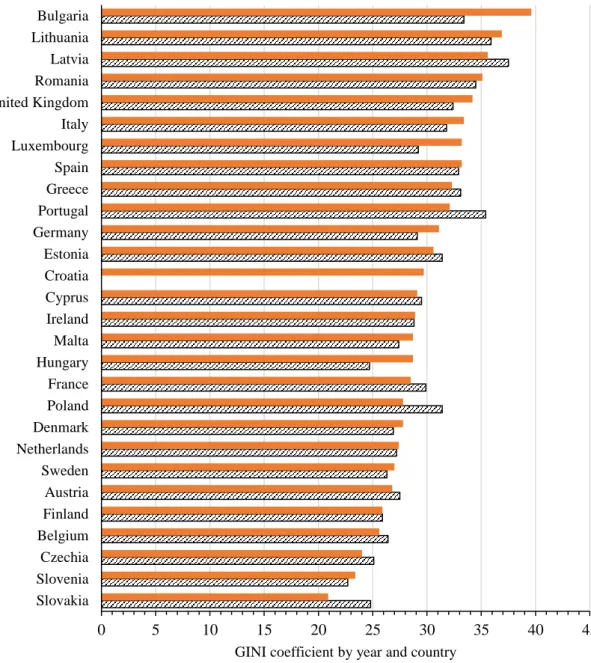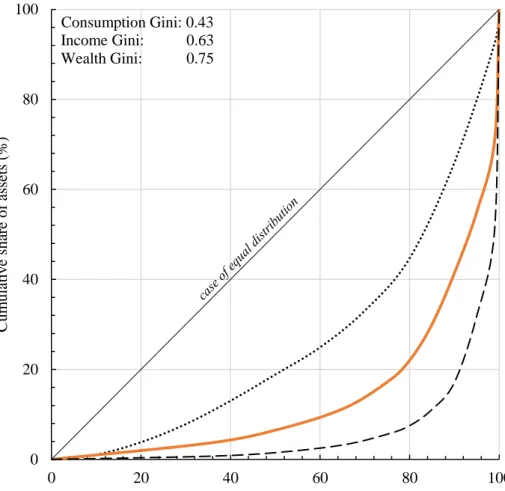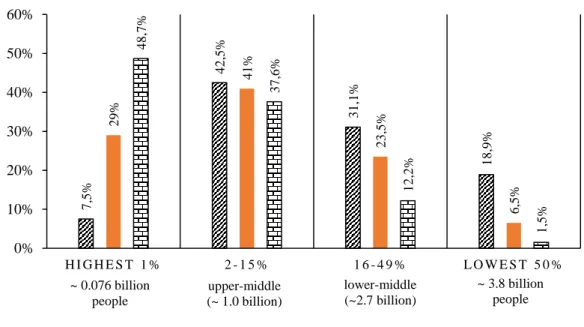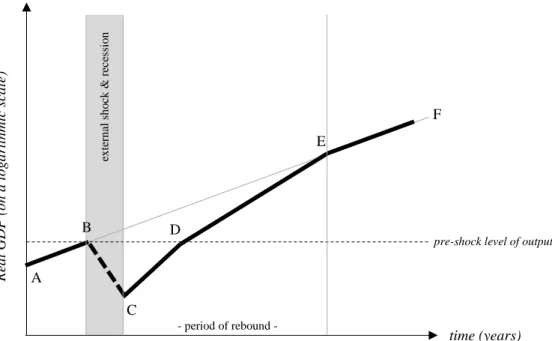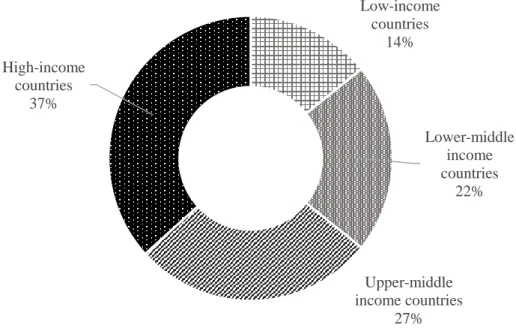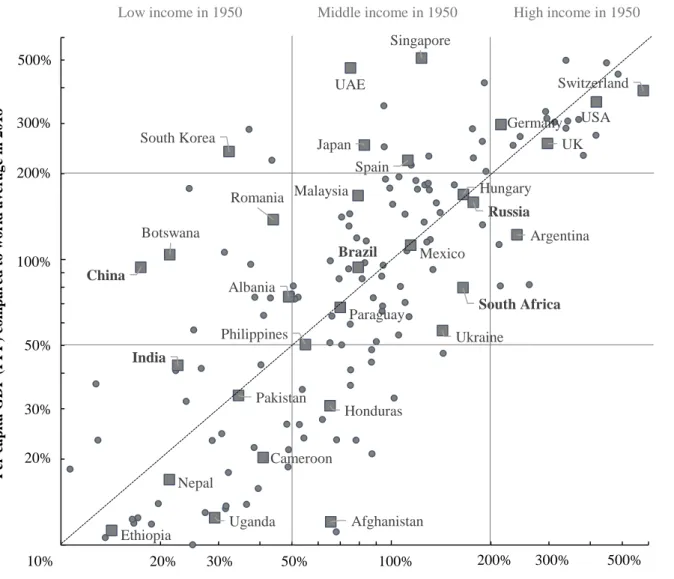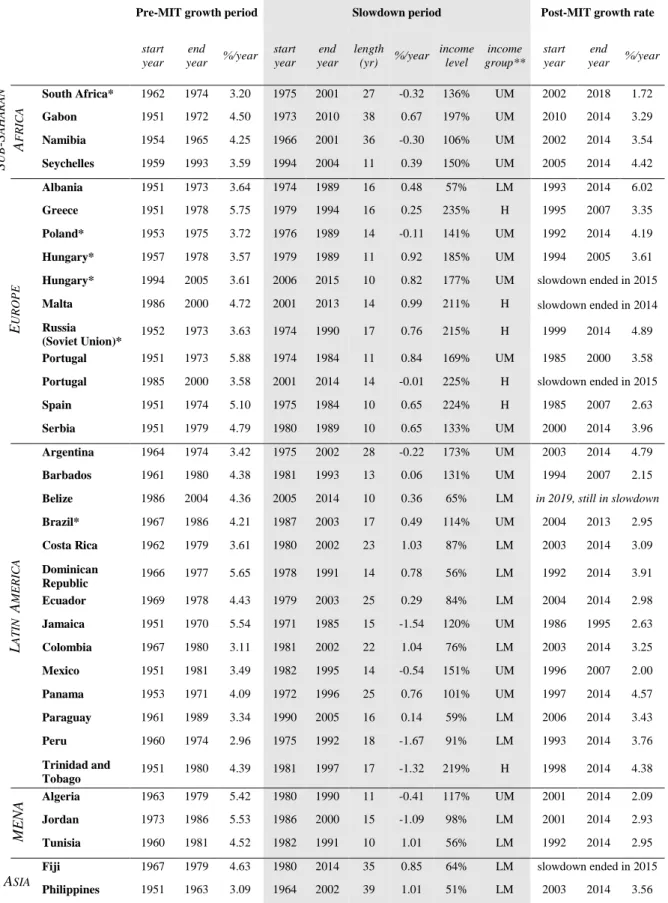~ I ~
DOCTORAL (PhD) DISSERTATION
KRISZTINA SŐREG
University of Sopron Sopron
2020
~ II ~
~ III ~
University of Sopron
Alexandre Lamfalussy Faculty of Economics
István Széchenyi Management and Organisation Sciences Doctoral School
PROTRACTED GROWTH SLOWDOWNS AND INCOME TRAPS IN THE DEVELOPMENT PATH OF EMERGING ECONOMIES
Comparative Analysis of the BRICS and CEE Economies
DOCTORAL (PhD) DISSERTATION
KRISZTINA SŐREG
Sopron 2020
~ IV ~
TARTÓS NÖVEKEDÉSI LASSULÁSOK ÉS JÖVEDELMI CSAPDA EPIZÓDOK A FELZÁRKÓZÓ GAZDASÁGOK FEJLŐDÉSI ÚTJÁBAN A BRICS-országok és kelet-közép-európai gazdaságok összehasonlító elemzése
Értekezés doktori (PhD) fokozat elnyerése érdekében
Készült a Soproni Egyetem Széchenyi István Gazdálkodás- és szervezéstudományok Doktori Iskola Nemzetközi gazdálkodás programja keretében
Írta: Sőreg Krisztina
Témavezető: Dr. Artner Annamária ………
(aláírás) Elfogadásra javaslom (igen / nem)
A jelölt a doktori szigorlaton 95 %-ot ért el, Sopron, 2018. augusztus 28.
………
a Szigorlati Bizottság elnöke Az értekezést bírálóként elfogadásra javaslom (igen / nem)
Első bíráló (Dr. …...) igen / nem ………....
(aláírás)
Második bíráló (Dr. …...) igen / nem .………..………...
(aláírás) A jelölt az értekezés nyilvános vitáján ……... %-ot ért el.
Sopron, 2019. ………
………
a Bírálóbizottság elnöke
A doktori (PhD) oklevél minősítése: ……….
………
Az EDHT elnöke
~ V ~
“Economic growth without social progress lets the great majority of the people remain in poverty, while a privileged few reap the benefits of rising abundance.”
John F. Kennedy, March 14, 1961
~ VI ~
CONTENT
1. INTRODUCTION ... 1
1.1 Motivation for the research topic ... 1
1.2 Background, purpose and main questions of the research ... 2
2. RESEARCH METHODOLOGY AND SOURCES ... 7
2.1 Data and methods ... 7
2.2 Structure of the research... 8
3. THEORETICAL OVERVIEW AND METHODOLOGICAL FRAMEWORK OF GROWTH AND DEVELOPMENT STUDIES ... 10
3.1 Basic theoretical approaches of economic growth ... 10
3.2 Development asymmetries, inequalities and economic growth ... 33
3.3 Growth Tendencies of the Developing Economies ... 45
4. THE MIDDLE-INCOME TRAP PHENOMENON ... 53
4.1 Income traps or convergence plateaus: facts and misconceptions ... 53
4.2 The definition, methodology and critique of the middle-income trap ... 55
4.3 An empirical approach to define the middle-income trap ... 58
5. CONVERGENCE PATH OF THE BRICS ECONOMIES AND CENTRAL AND EASTERN EUROPEAN COUNTRIES IN LIGHT OF THE MIDDLE-INCOME TRAP ... 73
5.1 Comparing the BRICS country group and the CEE economies ... 73
5.2 The economic growth path and post-crisis slowdown of the BRICS countries ... 79
5.3 Dependent market economies of Central and Eastern Europe ... 98
6. CONCLUSIONS ... 124
REFERENCES ... 133
I. Books, chapters in books and doctoral dissertations ... 133
II. Journal articles ... 137
III. Online working papers ... 140
IV. Other online sources and websites ... 142
V. Online newspaper articles ... 144
VI. Datasets and statistics ... 145
RELEVANT PUBLICATIONS OF THE AUTHOR ... 147
SUPPLEMENTARY MATERIAL ... 149
Appendix 1. Hungarian (reconstructed) per capita GDP since 1869 at fixed prices ... 149
Appendix 2. Classification of countries by their relative level of development ... 152
Appendix 3. Identifying protracted growth slowdowns in middle income countries ... 156
Appendix 4. Statistical hypothesis testing for randomness in slowdown periods ... 157
Appendix 5. Quarterly commodity prices and performance of the BRICS group ... 162
Appendix 6. Estimating the long-term growth trendlines for the BRIC economies ... 167
Appendix 7. Basic data for the multiple linear regression model applied on CEE11 ... 168
Appendix 8. Detailed results of the CEE11 multiple linear regression... 172
ACKNOWLEDGEMENTS ... 173
~ VII ~
LIST OF FIGURES
Figure 1: Equilibrium and growth from the neoclassical perspective ... 17
Figure 2: The Big Push Model ... 37
Figure 3: Main fields of inequality studies ... 39
Figure 4: Gini coefficient of EU28 countries in 2009 and 2018 ... 42
Figure 5: Representative Lorenz curves of the global inequalities (2018) ... 44
Figure 6: Distribution of resources among the global population ... 45
Figure 7: Effect of an external shock on growth path according to Jánossy’s model ... 49
Figure 8: Empirical estimation of Hungary’s long-term rate of economic growth ... 50
Figure 9: Distribution of economies in the world by income in 2018 ... 58
Figure 10: Changes in relative income levels by country, between 1950 and 2018 ... 60
Figure 11: The distribution of the initial dates of protracted growth slowdown periods ... 66
Figure 12: The distribution of the closing dates of protracted growth slowdown periods ... 68
Figure 13: A proposed categorization of all countries by their observed convergence path ... 70
Figure 14: Real quarterly GDP growth rate of the BRICS economies (2001-2020)... 82
Figure 15: Comparison of the four-year average growth rates in different countries ... 88
Figure 16: Frequency and distribution of commodity price changes in the world economy ... 91
Figure 17: Export structure of the BRICS in 2014... 93
Figure 18: Long-term economic growth (GDP per capita, constant 2010 USD) of the BRIC ... 97
Figure 19: Pre-crisis growth rates and the maximum depth of recession in CEECs ... 102
Figure 20: Initial income levels and long-term growth rates in the CEECs ... 103
Figure 21: Relation of annual GDP growth rates to external balance ... 105
Figure 22: Annual FDI inflows and cumulative stocks at current prices of the V4 countries .. 112
Figure 23: Net FDI inflows as a percentage of GDP for V4 and B3 countries ... 114
Figure 24: Growth performance of CEE countries compared to Germany and EU ... 120
~ VIII ~
LIST OF TABLES
Table 1: Growth and slowdown periods of middle-income countries ... 65
Table 2: Global economic importance of the CEE region compared to the BRICS ... 77
Table 3: Comparative analysis of the BRICS economies’ performance ... 87
Table 4: Cross correlation between commodity price indices ... 92
Table 5: Cross-correlation of economic growth in the BRICS economies ... 95
Table 6: Regression on GDP growth in the CEE11 group for 1996-2016 (excl. 2009)... 106
Table 7: Main economic indicators of the V4 countries (2006/07-2017/18) ... 107
Table 8: Main economic indicators of the ‘B3’ and Hungary (2006/07-2017/18) ... 110
Table 9: Freedom rating of selected CEECs (2019) ... 116
Table 10: Largest import and export partners of the V4 and B3 countries (2017) ... 118
~ IX ~
PROTRACTED GROWTH SLOWDOWNS AND INCOME TRAPS IN THE DEVELOPMENT PATH OF EMERGING ECONOMIES
Comparative Analysis of the BRICS and CEE Economies
(Summary)
In the long term, the development path of any economy or country group is usually representing a cyclical pattern of faster, convergence-based phases and also shorter or more protracted slowdown periods occasionally combined with some stagnation episodes. In our globalized 21st century world economy, it is also typical that in the periphery regions, growth rates during the expansion and recession periods are more volatile meaning that in frames of current global capitalism, there is a higher probability that more intensive growth cycles are followed by more significant economic downturns.
Current Thesis investigates growth tendencies in two special groups of emerging economies: the BRICS’ – as global semi-peripheries – and some selected Central and Eastern European countries – as integrated peripheries – being defined within the research as dependent market economies. Also, it is tested whether these economies have been affected by the middle-income trap (‘MIT’) phenomenon which might be characterized with fast converging growth periods followed by significant recessions and thus having relevant influence on long term convergence. The research puts special emphasis on the growth trajectories of Hungary as it has produced altogether two MIT episodes since the 1950s and is currently drifting towards a very high rate of dependency within the region.
~ 1 ~
“Economic growth has thus become the crucial juncture where almost all modern religions, ideologies and movements meet. The Soviet Union, with its megalomaniac Five Year Plans, was as obsessed with growth as the most cut-throat American robber baron. Just as Christians and Muslims both believed in heaven, and disagreed only about how to get there, so during the Cold War both capitalists and communists believed in creating heaven on earth through economic growth, and wrangled only about the exact method. Today Hindu revivalists, pious Muslims, Japanese nationalists and Chinese communists may declare their adherence to very different values and goals, but they have all come to believe that economic growth is the key for realizing their disparate goals.”
Yuval Noah Harari: Homo Deus: A History of Tomorrow, 2017
1. INTRODUCTION 1.1 Motivation for the research topic
There is no doubt that fast economic growth of emerging countries produced in recent decades is playing a vital role in the overall development of our world economy. Periods of significant growth and slowdown have considerable effects on global economic tendencies – and also, peripheries depend on the business cycles of the centre – and market processes in both more and less developed regions. Over the last ten years, the average growth rate of GDP per capita has been almost double that of the developed economies. It is also a well-known fact that in case of latter countries, the financial crisis of 2007-08 has had quite devastative impacts, especially regarding the protracted recession period in the European Union. However, developing economies have been much more affected by recent downturn due to the crisis accumulation process going on within the region for decades. Recessions are much more severe in emerging economies due to the previous higher growth rates.
In frames of current Thesis, the issue under scrutiny is the overall economic development of two selected groups of emerging economies: on one hand, the analysis is carried out regarding the so-called BRICS country group (Brazil, Russia, India, China and South Africa – occasionally narrowed to the BRIC classification) and on the other hand, two selected groups of the Central and Eastern Economies (CEECs) countries – an extended range of CEECs as well as the Visegrad Four economies (the Czech Republic, Hungary, Poland and Slovakia). Despite the geographical distance as well as significant socio- economic differences, both groups of countries have managed to produce relatively high growth rates and also, episodes of protracted slowdowns. However, the phenomenon of the middle-income trap (hereinafter referred to as ‘MIT’) and the status of dependent
~ 2 ~
market economies also serve as common elements in the specified countries, so the novelty of current research lies in the analytical framework applied to examine the presence as well as characteristics of both factors in our two focus groups regarding long term economic growth and convergence. What factors might determine the short and long-term development and catching-up of certain regions of the world? Can triggers which possibly contribute to slowdown periods, be classified according to any accurate method that might be economically legitimate for more than one nation state? What is the relationship between dependent market economies theory and the middle-income trap?
To continue, it is also important to investigate which country group and why has been performing in an efficient way during the last couple of decades in relative terms. Can asymmetric interdependencies be blamed for the long-run economic divergence of certain – usually middle-income level – countries which are struggling to catch up to the more developed economies but are failing to achieve latter goal with the current conditions of global capitalism? In order to have a more comprehensive macroeconomic approach of the issue, the Author has developed a new definition for the middle-income trap phenomenon by focusing on both exogenous as well as endogenous factors of the economic development concerning the BRICS’ and the CEE economies’ growth path.
The research carried out in the Thesis pays special attention to the case study of Hungary since it is representing one of the most ambivalent development models within the analysed economies. Thus, it raises some further questions about the long-term development tendencies of strongly FDI-based, small and open economies.
1.2 Background, purpose and main questions of the research
The purpose of current research is to contribute to a special sphere of economic growth and development studies that is the dependency theory approach reduced to the so- called dependent market economies perspective. In frames of latter approach, the Author provides a new theoretical and analytical method by combining dependent market theory with the middle-income trap phenomenon through the examination of the BRICS as well as selected CEE economies. Although current thesis should be primarily regarded as a synthesis of an applied research involving more than five years of efforts, the Author still thought important to provide an extensive literature review in order to make the background and main purpose of the research easy to understand.
~ 3 ~
The main background of the research is provided by the classical, alternative and modern growth and development theories and their interpretation of economic growth, development of countries and the main causes of different inequalities that are accumulating due to asymmetric interdependencies in our globalized world economy and current form of capitalism. A strong long-term cyclical approach has been applied throughout the research in the attempt to find patterns of protracted growth slowdowns in the investigated dependent economies. The Author develops an alternative definition of economic dependency for the analysed country group and also presents the main framework and preconditions of the research carried out according to the following:
(1) The long-term growth and economic development of our world economy has a cyclical nature, which is connected to the cycles occurring in the return of invested capital assets and the progress of technological innovation. This phenomena was extensively studied in the early 20th century by Kondratiev (1925). However, in recent decades, globalization and the onset of the information age has greatly contributed to the decreasing duration of each cycle.
(2) Economic growth and development are nonlinear and non-constant processes usually cross-cut by several endogenous and exogenous factors leading to periodical crises and the evolution of new economic models or varieties of capitalism.
(3) If we would like to get a realistic picture on the prospects of economic convergence of middle-income economies, then the patterns of their development paths should be examined on a lengthy, preferably multi-decadal timescale. The possibility of economic convergence (or the lack of it) could be only assessed after several decades of observational data become available. To achieve this perspective, with the combination of several sources, the Author gathered time series on income levels and economic growth rates for more than 100 countries starting in the 1950s.
(4) Our 21st century world economy might be best viewed as a transnational monopoly-capitalism system based on Rozsnyai’s (2002) research which is dominated by the hectic activity of trans- and multinational companies (and some other relevant owners of large assets) seeking new areas for cheap resource
~ 4 ~
colonization through usually underpaid labour force and making attempts to further increase their profit rates.
(5) As a result, the world economy is predefined by asymmetric interdependencies manifested in the growing inequalities of development among countries and country groups. However, instead of the classical Wallerstein approach of centre, semi-periphery and periphery, the research is based on Artner’s interpretation (2014, 2017 and 2018) of global core, global periphery, global semi-periphery, integrated periphery, integrated semi-periphery and finally, immanent periphery and semi-periphery and their furtherly integrated forms.
(6) Both examined country groups (BRICS and CEECs) are viewed as two special manifestations of dependent market economies. While former group are mainly characterised by an excessive internal market, large labour force and fair domestic savings for continuous development, the CEEC region is comprised of small open economies which are highly integrated to each other and the more developed part of the EU. The strictly defined Central and Eastern European region has 11 countries which are EU members (CEE11), together, they have a population of about 100 million. If we take into account other countries (such as Ukraine, Serbia or Albania) which are not EU members but have an association agreement, free trade agreement or candidate status, the region’s population climbs up to nearly 180 million. The latter value is comparable to the market size of Brazil or Russia.
(7) Dependent market economies are much more predestined to develop a middle- income trap phenomenon which might further contribute to their dependency in lack of the appropriate politico-economic interventions.
(8) According to the available data, we are assuming that in certain emerging economies with a high extent of dependency and some special conditions, an endogenous growth rate (the constant, positive per capita growth rate achieved without external technical progress) originally developed by Ligeti (2002) might not be realized during the next decades and thus it puts significant obstacles to long-term convergence.
~ 5 ~
In what follows, the Author is briefly presenting the five fundamental hypotheses developed within current research. These are being grouped into three main theses: Thesis I. and II. are containing only one-one individual hypothesis.
THESIS I.GROWTH TENDENCIES OF THE DEVELOPING ECONOMIES
- H1: Global semi-periphery economies (e.g. BRICS country group) – due to certain favourable endogenous and exogenous factors (geographical location, high raw material and natural resource abundance, huge domestic market, beneficial demographical tendencies, “follower based” technological developments or periodically increasing/decreasing global competitiveness) – are holding high potential of realizing a successful catching-up path and thus significantly redefine the power balance between centre and periphery economies.
THESIS II.THE MIDDLE-INCOME TRAP PHENOMENON
- H2: The integrated periphery economies (e.g. Central and Eastern European Countries) – due to their historical burden based asymmetric interdependencies (high dependence on foreign direct investment inflows, relatively small domestic market and purchasing power, lack of natural resources and raw materials, the cumulated economic divergence since the change of the regime in case of Central and Eastern Europe and middle-income trap episodes) are not likely to produce significant long-term convergence to the Western European centre with the current conditions of global capitalism. The relatively small-scale and in most cases, hectic development of such highly dependent market economies might be rather viewed as a special case that usually emerges only in certain economies having initial advantages.
Meanwhile, Thesis III. is comprised from three sub-hypotheses (H3, H4 and H5). Each of them are related to specific issue regarding the long-term convergence potential of a single middle income economy or a group of greater interest:
~ 6 ~
THESIS III.CONVERGENCE PATH OF THE BRICS AND CEEC ECONOMIES IN LIGHT OF THE MIDDLE INCOME TRAP
- H3: The growth dynamics of the BRICS countries shows strong correlation with the fluctuation of commodity prices, especially in case of the raw materials and natural resources.
- H4: The process of accession to the European Union - by stimulating foreign investment to the region - has strongly contributed to the significant pre-crisis growth as well as to the post-crisis persistent growth slowdown in Central and Eastern European Countries.
- H5: Strictly in economic frames, Hungary has been showing a significant diverging tendency from the Visegrad Four countries since the mid-2000s and thus represents a special case within the country group having possible further implications regarding its catching-up path. Further, based on Jánossy’s trendline theory calculations, Hungary’s long-term (of almost a 100 years long period) average GDP per capita growth rate is around 1.8 percent per year, indicating that it has been neither converging nor diverging to the most developed economies.
❖
~ 7 ~
“Measurement aside, there are two reasons aggregate growth might matter. The first is to create jobs to assimilate the unemployed and anticipate increases in population. The second is to improve living standards. Economic logic does not require overall expansion to achieve either of these objectives. An expanding labour force can be accommodated if hours of work fall. And it's productivity growth, rather than the overall size of the economy, that drives improvements in living standards. Getting bigger doesn't necessarily yield wealth; improving productivity does.”
Juliet Schor: Plenitude: The New Economics of True Wealth, 2010
2. RESEARCH METHODOLOGY AND SOURCES 2.1 Data and methods
In order to provide an extended analysis of growth slowdowns and economic growth episodes of the selected countries, the dissertation composes of both qualitative and quantitative research methods. As it has been already mentioned, Chapter 3 provides a theoretical comparison of the different economic growth related approaches and models in frames of a secondary research. On the other hand, starting with Chapters 4 and 5, the Author is introducing several empirical methods with the aim of detecting growth trajectories of the BRICS and CEECs as well as to find some middle-income trap episodes by developing a new system for latter phenomenon. The following quantitative tools have been applied within the research:
• comprehensive micro and macro level data comparison regarding the investigated countries’ economic performance relying on the databases provided by several international organizations (see beneath) as well as the researched countries’ statistical bureaus’ information;
• statistical and econometric models and analyses (e.g. Jánossy’s trendline model);
• statistical hypothesis testing and comparison of samples (e.g. probability of slowdown episodes, randomness testing of the order of years with slowdown periods, covariance of closing years of slowdowns within country groups, etc.);
• prediction models such as two- and multiple variable regressions and variance analysis (ANOVA).
~ 8 ~
In course of the Author’s empirical research, the following sources have been used with the highest frequency:
- CIA – The World Factbook;
- Eurostat;
- IMF Data;
- National statistical office databases provided by the examined economies;
- OECD Statistics;
- The Fraser Institute – Economic Freedom Index;
- The Maddison Project Database;
- The World Bank – World Development Indicators;
- UNCTADSTAT;
- WEF – Global Competitiveness Reports;
2.2 Structure of the research
Following the introduction of the chosen research field as well as a methodological summary of the applied quantitative means and models, the research topic investigated in the dissertation is introduced by an extended theoretical overview of growth theories and development studies with a special focus on development asymmetries in frames of Chapter 3. From the classical approach to the modern growth theories, the Author provides a brief analysis of the most relevant statements, conditions and characteristics of economic growth, growth slowdowns and economic development based approaches which are significant from the point of view of current research topic.
Chapter 4 is representing the congestion point of both theoretical and practical approaches by introducing in details the middle-income trap concept. After presenting the recent results in the field of current scientific literature, the Author is developing an alternative definition and calculation method for the phenomenon relying on The World Bank World Development Indicators (WDI) as well as the Maddison Project Database.
This section also publishes the findings of the Author regarding those countries’ income trap episodes over the last almost 70 years which might be detected with the above- mentioned technique. The core of the research is provided in Chapter 5 where the
~ 9 ~
development path of the BRICS economies and Central and Eastern European countries is presented by analysing the main characteristics of economic dependency, detecting the basic triggers of growth which contributed to successful convergence episodes and revealing the critical points of the socio-economic as well as political and international environment of the countries that possibly provoked significant slowdown stages in their growth path. The final chapter (Chapter 6) of the dissertation serves as the concluding block of the research with referring back to the original hypotheses introduced in Chapter 1 and also the most significant findings of the Author.
❖
~ 10 ~
“The general economic growth of the quarter of a century that followed World War II not surprisingly created many illusions. In the West, people thought that they had found in Keynesianism the definitive solution to the problem of crises and unemployment. It was thus thought that the world had entered into an era of perpetual prosperity and definitive mastery of the business cycle. In the socialist world, it was also thought that the model formula for even higher growth had been discovered which enabled Khruschev to announce victoriously that by 1980 the USSR would have overtaken the United States "in every domain." In the third world of Africa and Asia, the national liberation movements which had seized political independence, also had a battery of prescriptions which, in a mix of capitalist and socialist recipes, in doses that varied from case to case, would enable these movements to overcome "underdevelopment" in "interdependence.”
Samir Amin: The Social Movements In The Periphery: An End To National Liberation? 2006
3. THEORETICAL OVERVIEW AND METHODOLOGICAL FRAMEWORK OF GROWTH AND DEVELOPMENT STUDIES
3.1 Basic theoretical approaches of economic growth
In what follows, the Author is providing a comprehensive overview of the most relevant economic approaches organized in two main sections of this Chapter. First, there is an introduction to the most significant growth theories dating back to the main concepts established by Adam Smith to nowadays’ new directions and disciples until the modern interpretations of economic growth. Second, the Thesis provides a complex analysis of the most important development economics based approaches including a methodological review of the available tools and techniques for evaluating the development path of a given economy or group of countries. In both cases, the issue under scrutiny is to find definitions, characteristics, methods, patterns and also their critics regarding economic growth, development and inequality interpretations in order to draw an outline of the relevant changes undergone in our globalized world economy.
3.1.1 Classical approach
There have been several explanations to the economic growth and development of countries over the past decades and centuries throughout history. Among the first ones, Adam Smith1, the emblematic figure of the Classical economic theory stated that the
1 Scottish economist, philosopher (1723 – 1790). It is not widely known, but his writings on free market economic theory, rational self-interest and competition were very controversial in their own day.
~ 11 ~
most significant base of growth is the available labour force of a given country which is able to produce all the goods necessary for their own life as well as for purchasing some products from other nations which are scarce or not available at all. The ratio of the population holding resources and thus being able to buy more is determined by two main factors: on one hand, Smith indicates the skills of the labour force and on the other hand, the number of employed and unemployed people. Basically, Smith was the first economist highlighting the importance of human capital from the point of view of economic development in the 18th century also emphasising the importance of skilled labour force (Smith, 1776).
Smith is also driving our attention to the way human capital productivity might be increased by presenting three main conditions (Smith, 1776, p. 10):
1. developing skills – or “dexterities” – of labourers;
2. decreasing working time per work activity through time saving methods;
3. developing new technologies (“appropriate machinery”) that enable labourers to carry out much more work per individual.
Besides the usual, growth-orientated analysis, “The Wealth of Nations” also offers some contribution to inequality studies relevant in current Thesis. Smith argues that certain European policies made attempts to restrain competition regarding employment, although there would have been capacity for more. The opposite of the above-mentioned tendency is also imposing risks towards a more equal society (increasing employment above its natural level, for example, by supporting the education of the clergy). Thirdly – and probably this is the strongest argument within the topic, – putting obstacles into the way of free labour flow, e.g. the special role of apprenticeship not allowing young workers to shift their field of work or some privileges of corporations such as high wages (Smith, 1776). However, the introduction of the concept of the “invisible hand” making the reallocation of the available resources the fairest system, raised some concerns and was often heavily criticized (Smith, 1776 & Engel, 2010).
Following Adam Smith’s theory, the research aimed at economic growth was further developed among many others, by Thomas Malthus2. In his famous work entitled “An Essay on the Principle of Population” and published at the end of the 18th century, the
2 In his early life, Malthus (1776-1834) was a cleric in England, but later became influential in the fields of economics and demography. Malthusian thoughts are commonplace in the environmental movement.
~ 12 ~
author is raising awareness to the strong connection between economic growth and rapid population increase. “Population, when unchecked, increases in a geometrical ratio.” – states the essay (Malthus, 1798, p. 4). Inequality is thus viewed by Malthus as the disproportionate relation between human population and production of the earth (i.e. the scarcity of natural resources). To be more precise, securing the right to private property and introducing the institution of marriage, inequalities will certainly arise in any society according to his views (Malthus, 1798).
To continue, one of the main statements of Malthus as well as his followers was that there is a complex relationship between the population growth rate and the standards of living of a given economy. Malthus observed that growth in food supply, due to better practices in agriculture or a series of years with favourable weather conditions improved the well-being of the populace, but this improvement was only temporary because it led to population growth. According to some recent research, latter hypothesis may had been valid in the late 18th century, but in the last 50-100 years it is not, since in most developed economies with high standards of living birth rates are often below replacement level.
The second Malthusian conclusion states that higher population contributes to falling standards of living. In this form, the statement is also doubted since there are many countries with relatively high population density being far from poor, both in Europe and Asia. There might be several other factors that equalise the negative outcome of large population or rapid population growth, so poverty will not necessarily emerge of such conditions (Weil-Wilde, 2010).
David Ricardo3, in his famous book entitled “On the Principles of Political Economy and Taxation” from 1817, stated that foreign trade in itself would cause the growth of any given economy’s value but it would certainly generate the volume of commodities of the country. The famous comparative advantage theory that he developed gives an explanation for achieving greater economic growth. Ricardo claims that such country might realize economic growth as the one that is able to trade its goods within the manufacture having comparative advantages. The beneficial effects of foreign trade can be utilized if there are no obstacles to the flow of goods (Ricardo, 1817). Thus, the author highlights the negative consequences of trade barriers (protectionism) from the point of view of long term economic growth and development. Another relevant outcome of the
3 British political economist (1772 – 1823) with Hispanic Jewish and Portuguese origin. Ricardo started working with his stockbroker father in his teens, showing interest towards economics at a very young age.
~ 13 ~
Ricardian model is that economic growth has to fall, deteriorate and finally, to come to an end due to the fact that land is a scarce resource and it also has decreasing marginal productivity. Although in this form, several arguments might be raised towards the ending economic growth, many other economists further developed this idea. For example, Keynes (1936) was also inspired by the thought when explaining the possible origins of macro-stagnation that he owed to the significant aggregated demand based insufficiency in countries being partly protectionist (Formaini, 2004).
3.1.2 The Marxist and socialist critique of the classical approach
Although such classical economists as Smith, Malthus, Ricardo, Bentham or Say greatly contributed to the classical, ‘laissez-faire’ based economic approaches, there were many contradictions in their statements later argued by such thinkers as Karl Marx4 and his followers. In his book “A Contribution to the Critique of Political Economy”
published in 1859, Marx analyses the weaknesses of Smith’s theory: Smith describes the commodities’ value to be calculated by labour-time in a society where there are no classes (e.g. capitalists, labourers, etc.). “We see then that which determines the magnitude of the value of any article is the amount of labour socially necessary, or the labour-time socially necessary for its production.” – expresses Marx in his “Capital Vol. I” work (Marx, 1958, p. 39). Marx states that it is not correct to think that the division of labour assumes individual exchange (Marx, 1859). Also, regarding Ricardo’s achievements, the critique aims at the incoherent interpretation of the value and price relationship (Pilling, 1980).
However, the biggest difference between the two schools is that classical economy views capitalist system as being integrated into the natural law while Marxists are convinced that it is only a temporary phase between feudalism and socialist economy. The industrial revolution provoking a huge shift in economic thinking was creating – according to Marx – the layer of capital owners and the workers exploited (Tri, 2008).
The exploitation of labourers has two consequences: capital accumulation as well as an inadequate purchasing power of the working class. Marx emphasized the role of
4 German philosopher (1818 – 1883), possibly the most influential critic of free-markeeter classical economics. Early in his life, in 1843, Marx became stateless because of his thoughts and publications.
Thereafter, he left Prussia and lived in exile with his wife and children in London for decades where he continued to develop his alternative theory of social and economic development. The reading room of the British Museum was his primary place of doing research.
~ 14 ~
decreasing profit rates which are repetitively leading to crises in case of a capitalist way of production: these crisis periods are provoking the (further) concentration of capital, wealth, and they are leading to increasing unemployment, the total social deprivation of the proletariat and finally, a social revolution (Fusfeld, 2002). It might be concluded that based on Marx’s research, inequalities and thus the lack of development result from the appropriate functioning of industrial capitalism (Tri, 2008). After the death of Marx, Friedrich Engels5 edited and published the second and third volumes of the Capital.
3.1.3 Neoclassical growth models
Neoclassical economics dates back to the second half of the 19th century and represents a new milestone in economic theory by focusing on consumption, utility, demand as well as equilibrium (Engel, 2010). The new approach was introduced by the so-called marginal revolution and is associated with such thinkers as Jevons, Menger or Walras.
Instead of the labour based approach originating from Adam Smith, willingness to pay was represented by the function of value. Also, the limited definition of the traditional physical market was finally extended to the concept of resource allocation platform (Kaldor, 2019). In 1890 Alfred Marshall6 published his “Principles of Economics” and thus greatly contributed to the development of marginalism as a second-generation thinker. During this period, economic growth and development gained new dimensions through the investigation of price mechanism, the importance of regulation and by realizing that in any country, all sectors and factors affect basically everything else (Marshall, 1920).
In 1928 Charles W. Cobb7 and Paul H. Douglas8 published their research entitled “A Theory in Production” which serves as a relevant base for later growth models presented in this Chapter. The authors prepared the thorough analysis of the US’ growth of fixed capital in manufacturing between 1899 and 1922. The mathematically formalised, new
5 Economist and sociologist of German origin (1820 – 1895). He was born into a wealthy family in Prussia, his father owned both English and German textile factories. Through his life he was engaged simultaneously in social sciences and doing business. In 1848, he co-authored ’The Communist Manifesto’ with Marx and later even supported him financially, contributing to the completion of ’Das Kapital’ in many ways.
6 One of the most influential neoclassical economists (1842 – 1924). Was born and lived in London, England. Although he emphasized on high level of mathematics, he never intended to overshadow economics with excessive calculus.
7 American economist (1875 – 1949), who was originally a mathematician and received his PhD in 1912.
8 American economist (1892 – 1976), he was also a politician, member of the Democratic Party and served as a senator from Illinois for 18 consecutive years, between 1949-67.
~ 15 ~
Cobb-Douglas production function is built on two factors of production, labour and capital and might be expressed as the following:
𝑌 = 𝐾
𝛼(𝐴𝐿)
𝛽(1),
where Y is the macroeconomic gross output, K is the available physical capital and L is the employed labour force for the given year. A is representing the technological level of the use of the factors of production and is called Total Factor Productivity (TFP). The two exponents (α and β) refer to the elasticity of capital and labour utilization of gross output (Cobb-Douglas, 1928):
𝛼 = 𝜕𝑌
𝜕𝐾 ∙ 𝐾
𝑌 (2𝑎) 𝛽 = 𝜕𝑌
𝜕𝐴𝐿 ∙ 𝐴𝐿
𝑌 (2𝑏)
During the 1950s Robert Solow9 and Trevor Swan10 developed a neoclassical growth model which later became well-known as the Solow-Swan growth model11 and enabled to prepare the analysis of the long term economic growth process and its main factors.
The base of the model is the Cobb-Douglas production function and it assumes that capital depreciation (), saving rate (s), population growth rate (n) and technological level (g) are fix constants. It is also known as the balanced growth path to which the given economy is converging in the long run regardless of its initial level of development and its common form is the following (Solow, 1956):
𝑦 = 𝑘
𝛼(3)
where y=Y/AL is the output per labour applied that is equal to k=K/AL.
9 Neoclassical growth economist (1924 – ), his first studies were sociology and anthropology. After a couple of years, he returned to university and completed an economics program. Later on he became interested in statistics and econometrics. Since the 1950s, his institution is the MIT in Boston. Received the Nobel Prize in economic sciences in 1987 and four of his former PhD students, George Akerlof, Joseph Stiglitz, Peter Diamond and William Nordhaus also received such prizes based on their outstanding research.
10 Australian economist (1918 – 1989), professor of economics at the Australian National University between 1950 and 1983, former board member of the Reserve Bank of Australia in the 1970s and ‘80s.
11 The model was published in 1956 under the name of Robert M. Solow in his article entitled “A Contribution to the Theory of Economic Growth”. In 1987 Solow won the Nobel Prize for his great contribution to economic growth. Swan also released a publication in 1956 (“Economic growth and capital accumulation”), yet, the two authors developed the model separately.
~ 16 ~
In frames of the model we assume first that future capital stock (K’) equals the sum of present capital stock (adjusted with amortization) and the sum of the investments in an economy:
𝐾
′= 𝐾(1 − ) + 𝐼 (4)
We also suppose that savings are realized at a constant rate, so they are representing only a certain, fix part of the total consumption of the population:
𝐶 = (1 + 𝑠)𝑌 (5)
To continue, population growth rate is increasing at a constant value, so it might be expressed similarly to the consumption equation with N’ being the future population:
𝑁′ = (1 + 𝑔)𝑁 (6)
Finally, our fourth and most relevant factor is technology which depends on capital as well as labour, thus production function is applied as what follows:
𝑌 = 𝑎𝐹(𝐾, 𝐿) (7)
In his article Solow claims that “An especially easy kind of technological change is that which simply multiplies the production function by an increasing scale factor” (Solow, 1956, p. 85).
The model also introduces the so-called steady-state situation where output and capital are constant over the examined period. The model states that countries converge to latter equilibrium in the long run. It might be demonstrated with the following central equation of motion:
𝑘
∗= 𝑠𝑓(𝑘) − (𝑔 + 𝑛 + )𝑘 (8)
How could we define economic growth and development as well as global inequalities relying on the model? According to Solow and Swan, the main outcome based on the above-mentioned conditions is that in the long run, only the change of technological progress can lead to overall economic growth. So the ‘g’ parameter is also called as the rate of labour-augmenting technological progress. Physical capital is not responsible for growth since there are significant differences among countries’ incomes. As for savings, we can come to a very similar consequence: yet a relatively high saving rate leads to a
~ 17 ~
higher steady-state level of Y, but it comes with a lower relative and possibly, even absolute level of consumption. Therefore, it cannot lead to persistent economic growth in the long run. Solow also predicted that economies with higher rates of population growth have lower levels of income per capita and lower levels of steady-state of capital per worker. Productivity growth improves consumption and investment simultaneously (see Fig. 1).
a) steady state level of output b) upward change in saving rate
c) elevated population growth d) technological progress y
k y*
k*
y(k)
s(k) (g+n+δ)k
i c
y
k
k0 k1
y1
y0
c0 > c1
i0 < i1
y(k)
(g+n+δ)k
s1(k) s0(k)
k y
y(k)
s(k) (g+n1+δ)k
(g+n0+δ)k
k0
k1
y0
y1
i1 < i0
c1 < c0
k y
y(k) y’(k)
s(k) s’(k) (g+n+δ)k c0 < c1
i0 < i1
k0 k1
y0
y1
Figure 1: Equilibrium and growth from the neoclassical perspective Source: Author’s own work based on Solow (1956)
~ 18 ~
An implication of the model is that countries with lower level of development necessarily grow faster and will finally catch up (or converge) to the developed ones (this is the so-called conditional convergence). As history has shown, this hypothesis might not be accepted. In 1992, Mankiw, Romer and Weil extended the original model with the accumulation of human capital factor which is correlated with ‘s’ and ‘g’. The authors assume that output is the combination of physical, human capital and also labour.
They also claim that convergence in income per capita is realized over a much longer time horizon calculating that an economy achieves its halfway to steady-state in 35 years compared to Solow’s 17 years (Mankiw-Romer-Weil, 1992).
3.1.4 Alternative schools of the 20th century
As it might be noticed, the most significant changes within the mainstream economic thinking usually occur following an economic crisis or if some other relevant shock is experienced/produced by the world economy. During the 1930s, the global economy was supressed by the Great Depression. Industrial output fell drastically, unemployment rate was skyrocketing (in the USA, the number of jobless persons increased by more than 600% in a timespan of just three years, between 1929-32), consumption dropped due to the poverty spreading quickly among people, banks crashed and foreign trade also decreased (-70 percent of change in the US for the same period) by an unbelievably high rate (Blum-Cameron-Barnes, 1970). The previously dominating neoclassical approach lost its ground being unable to find explanations to growing unemployment, falling prices, persistent deflation and not accepting the regulatory role of the state. In 1936 John Maynard Keynes12 published “The General Theory of Employment, Interest and Money” work in which he strongly criticized the neoclassical school and also aimed to provide an alternative vision of the economic development. Keynes realized that there is insufficient demand, unemployment is usually current, prices should be viewed as rigid and equilibrium might be only reached through the active interventions of the state (Keynes, 1936). Keynesianism thus represented a theory based on insufficient demand in contrast with the neoclassical belief in insufficient supply. The main intention of Keynes was to preserve liberal capitalism from crises as well as to prevent a socialist
12 British economist (1883 – 1946), founder of the interventionist school named after him. In addition to his theoretical work, Keynes contributed to the establishment of the Bretton Woods financial system, the creation of the International Monetary Fund and the World Bank in the mid-1940s.
~ 19 ~
revolution. Thus, economic growth and development might be achieved in a more effective way. Following the two world wars, the approach became the most popular first among the centre countries of high development and later among developing nations as well (Engel, 2010). Keynes’s principles have also had relevant influence on development economics formulation during the 1950s.
As it has been already mentioned, economic crises always accumulated more attention towards the long-term analysis of countries’ development. Thus, the so-called macro cycles or waves gained more and more importance during the first half of the 1900s.
During this period, evolutionist economics was on its rise and was represented among many others by Nikolai Kondratiev13, a Soviet economist who is famous for analysing and presenting the well-known “Kondratiev waves” of expansion, stagnation and recession. These long waves were later named by Joseph Schumpeter based on Kondratiev’s significant revelation, however, they are also named as K-waves. In 1925 he published his book entitled “The Major Economic Cycles” in which he explains that the introduction of innovations as well as technologies serves as a trigger for countries to move towards a new phase of development from the declining stage (Kondratiev, 1925).
Long-term capital cycles become even more intense in frames of global economy since they largely contribute to the expansion of global relations (Artner, 2014 & Grinin- Devezas-Korotayev, 2012). Yet, Kondratiev was not the only economist at that period to pay so much attention to the cyclical nature of economic development. After a couple of years, the construction cycles were specified by Simon Kuznets14 who indicated an approximately 17-30 year period for latter ones (Kuznets, 1930). The cycle theory has gained more and more importance over the decades and it was extended with many factors by several other authors engaged in this field of research, although there is no consensus among economists regarding the nature of the cycles. In Hungary, cycle theory has been also actively analysed directly or indirectly by such researchers, economists as Ferenc Jánossy, Tamás Szentes, András Bródy, Ervin Rozsnyai, Annamária Artner and Péter Szigeti.
13 Russian-soviet economist (1892 – 1938) proponent of economic reforms, victim of Stalin’s great purge.
14 Russian-born, American economist (1901 – 1985), who received the Nobel Prize (1971) in economic sciences for his unique and empirically based interpretation of economic growth which has led to new and much wider insight into the economic and social structure and process of development.
~ 20 ~
An alternative approach was also specified by an Austrian economist, Joseph A.
Schumpeter15 who contributed to the development of the evolutionary economics during the first half of the 1900s. He was examining the long term development of capitalism and introduced some more radical ideas, for example, that the evolution of capital is based on technological competition among firms. This idea originally came from Marx and both of them could agree that innovation might be constant since its positive effects on economic growth are only temporary due to the activity of the imitators (Fagerberg, 2003
& Schumpeter, 1954). In his book entitled “Capitalism, Socialism & Democracy”
Schumpeter introduced his most well-known concept of “creative destruction” defining it as a process having a nature of “…industrial mutation — if I may use that biological term—that incessantly revolutionizes the economic structure from within, incessantly destroying the old one, incessantly creating a new one” (Schumpeter, 1943, p. 83).
The economist also explains what he means by development: it is basically innovation which is created by using the already existing tools, resources, etc. (Schumpeter, 1934). It is also worth mentioning that Schumpeter did never view bigger firms as an obstacle of development, competition since innovations always emerge from smaller newcomers at the market (Fagerberg, 2003). Nowadays, we can partially verify his thoughts by reflecting on start-up firms creating the seeds of new technologies, methods or services. However, trans- and multinational companies’ activities might be doubted as not having any negative effect on global competition. Economic growth theory gained a new perspective in frames of a Keynesian approach by the Harrod-Domar model that is often applied in development economics. Similarly to the Solow-Swan model, it was developed separately by two economists: in 1939 by Roy F. Harrod16 and in 1946 by Evsey Domar17. The model’s two most relevant assumptions are that on one hand, growth rate depends on the level of national saving and on the other hand, the capital- output ratio. The proportion of these two factors basically result the growth rate of the gross domestic product in an economy. Regarding the definition of economic growth,
15 Schumpeter (1883 – 1950) was born in Moravia (territory of the modern Czech Republic), later he lived in Vienna and briefly served as finance minister for Austria in 1919. As a political economist, he became a professor at Harvard University in 1932 and even obtained U.S. citizenship.
16 British economist (1900 – 1978), besides his academic publications, he is best known for writing an excessive biography titled ’The Life of John Maynard Keynes’.
17 Russian-born, American economist (1914 – 1997), emigrated to the USA from the far eastern Soviet Union in 1936. Later, he graduated at Harvard University and received his PhD in Economics at the same institution in 1946.
~ 21 ~
Harrod specifies three versions in his publication entitled “An Essay in Dynamic Theory” (Harrod, 1939):
- warranted rate of growth: when production is neither more (uncontrolled growth) nor less (recession) than the appropriate amount;
- actual rate of growth: real rate of growth within a year experienced in an economy;
- natural rate of growth: the highest available rate of growth generated by population increase, capital accumulation, higher level of technology and the so- called work-leisure preference schedule with the assumption of full employment.
The Harrod-Domar model is thus determining an instable long-term economic growth path with no convergence for the countries. There is also no conditional convergence since economies are not drifting towards their long-term growth path. As a result, in most cases we might experience a constantly present and growing rate of unemployment or unutilized capital capacity. If convergence could still be realized, it would be achieved only towards a non-equilibrium growth path (Ligeti, 2002). The Harrod-Domar model has important implications for developing countries, where (unskilled) labour is a plentiful resource but capital is not. Lower income implies a higher proportion of autonomous consumption, which does not enable a sufficient rate of saving and investment. Therefore, accumulation of physical capital remains restricted, and as the economy does not "naturally" find full employment, growth in labour force and population cannot advance the economy. Economic growth might be created by stimulating savings and elevating the saving rate (s), increasing the marginal product of capital (MPk = c) or by slowing down the depreciation rate of capital stock ().
∆𝑌
𝑌
0= 𝑠𝑐 − (9)
The formula above came from simplifying the following relation between the marginal product of capital, the initial level and the measurable annual growth of gross output, the initial capital stock, saving and depreciation rate:
~ 22 ~
𝑐 = 𝑀𝑃
𝐾= 𝜕𝑌
𝜕𝐾 = 𝑌
(𝑡+1)− 𝑌
𝑡𝐾
𝑡+ 𝑠𝑌
𝑡− 𝐾
𝑡− 𝐾
𝑡(10)
The 20th century might be truly considered a productive era concerning the development of economic growth models. In 1960, an American economist, Walt Whitman Rostow18 published his famous magnum opus, “The Stages of Economic Growth: A Non- Communist Manifesto” and presented a 5-stage growth model as an antithesis of Marx’s theory of modern history claiming that politics, social organizations as well as culture have emerged from the economy. Rostow precisely defined the 5 stages of growth:
traditional society, preconditions to take off, drive to maturity, take off phase and finally, the age of mass-consumption. From the point of view of current Thesis, the most intriguing stage is the take-off phase. Rostow emphasises that change might provoke the take-off – or it might be even called convergence – by both endogenous and exogenous factors such as new level of technological development or for example, “…the emergence of political power of a group prepared to regard the modernization of the economy as serious, high-order political business” (Rostow, 1960, p. 8).
In the course of the second half of the 20th century, the world could witness another significant contribution to alternative schools’ theories by Immanuel Wallerstein19. In 1974, Wallerstein provided a full analysis of the world system theory in his work entitled
“The Modern World System I: Capitalist Agriculture and the Origins of the European World-Economy in the Sixteenth Century” as well as in many of his further publications.
However, the concept of world-system theory or paradigm20 was used by him only two years later21. In latter paper he clearly defines the main differences between the previously dominant developmentalist and the newly introduced world-system perspective. The developmentalist approach is putting the given social action into a politico-cultural
18 American economist and political advisor (1916 – 2003). He was remarkably anti-communist and worked as a speechwriter and foreign policy advisor to U.S. President John F. Kennedy and later to Lyndon Johnson. He was influential in shaping U.S. foreign policy in the 1960s, especially in Southeast Asia.
Expressed a strong support towards the Vietnam war, and never changed his views on the subject.
19 American sociologist and economic historian (1930 – 2019). Received both his BA, MA and PhD degrees from Columbia University. However, both studied and held visiting professorial titles at many institutions around the world. From 2000 until his death in 2019, Wallerstein worked as a senior research scholar at Yale University.
20 Different sources use both “world-system theory” and “world-systems theory” as an expression.
21 It was first mentioned in his publication entitled “A world-system perspective on the social sciences” at The British Journal of Sociology in 1976.
~ 23 ~
system or unit and aims to find the differences among them. On the other hand, the world- system perspective is focusing on a context based on the division of labour and presents empirical evidence to prove if the given system is tied politically and culturally22 (Wallerstein, 1976).
Wallerstein argues that world-systems analysis might be initiated from the mid-18th century when capitalist world economy had already been existing for two hundred years and there was an urge to create a framework of economic research, scientific analysis of countries’ development (Wallerstein, 2004). The author presents that the international division of labour based world-systems theory of semiperiphery, core and periphery economies is a social system build on strong tension caused by the frictions among different groups fighting for the interests as well as advantages. The theory was developed to counterweight the dualist nature of development studies which became widespread following the two world wars: Arthur Lewis’s23 work of “The Theory of Economic Growth” introduced the view that less developed economies have only two sectors (traditional and modern one) and further development, modernization might be achieved only through redistributing resources to the modern sector by an import- substitution based strategy (Lewis, 1955).
Wallerstein provides a much more sophisticated approach and explains the phenomenon of inequalities being constantly present in our history with the nature of capitalism:
“Capitalism is based on the constant absorption of economic loss by political entities, while economic gain is distributed to "private" hands.” (Wallerstein, 1974, p. 348). His research was strongly influenced by such thinkers as Marx, Kondratiev, Schumpeter or Karl Polanyi and the main concepts of modernization and dependency theory providing some new elements to latter approaches and thus criticizing their linear development approach for countries’ growth paths. Wallerstein also brilliantly combines Polanyi’s
22 Wallerstein is also providing an extended analysis of the topic in his research proposal entitled as
“Patterns of development of the modern world-system” developed with Terence Hopkins in 1977.
23 Caribbean-British economist (1915 – 1991). In 1979, he was awarded the Nobel Prize in economic sciences for advancing the understanding of economic growth and development (sharing the award with Theodore Schultz). Born into an Afro-American family on the island of Saint Lucia, he excelled at school from the beginning. His initial career choice was engineering, but after 4 years, he had to make a switch to economics because at his time both the public and private sector refused to hire blacks as professionals.
With a scholarship, he was the first Afro-American individual to ever gain admission to the London School of Economics in 1933. Received his PhD there in 1940. Later in his life, Lewis served as an advisor in numerous developing countries, such as Nigeria, Ghana, Trinidad and Tobago, Jamaica and Barbados.
